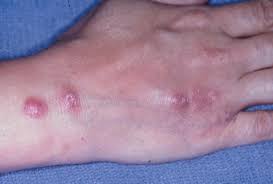 Caused by Sporotrichum genus (Sporothrix Schenckii), a fungal organism.
Caused by Sporotrichum genus (Sporothrix Schenckii), a fungal organism.
Estimated 200-250 cases per year or 1-2 cases per million population.
A dimorphic deep fungal infection limited to the skin in 95% of cases.
Exists as condiospores at room temperature and hyphal structured mold or yeast in vivo.
A worldwide fungus that can affect people of all ages.
Enters host through cutaneous or subcutaneous wound or by pulmonary inhalation of conidia.
Rarely by zoonotic transmission from felines.
Two forms :cutaneous and systemic.
Cutaneous has two forms: lymphocutaneous and fixed cutaneous.
Lymphocutaneous form manifested by a papule, pustule or an ulcerated nodular lesion that spreads proximally in a linear distribution along lymph channels within weeks to months of exposure.
Lymphocutaneous disease comprises 75% of all cases.
Lymphocutaneous disease is most often found on the hand, with similar subcutaneous nodules extending along proximal lymphatics.
Fixed cutaneous disease it is most commonly found on the face neck, legs, or trunk.
Multifocal or disseminated cutaneous disease is typically associated with an Immunocompromised host.
Extracutaneous or systemic disease can involve the meninges, osteoarticular areas, lung or systemic involvement are typically associated with an immunocompromised host.
Diagnosis based upon the disease onset, indolent progression and presence of cutaneous nodules in a linear fashion along locations of lymphatic drainage.
From inoculation to emergence of a nodule or plaque may days to weeks.
Lesions are small firm, red to violaceous and pain, if present, is mild.
Skin lesions are painless, ulcerated, verrucous or crusted and are often accompanied by regional lymphadenopathy.
Lesions characteristically ulcerate.
Fixed form of disease refers to a single or group of lesions confined to the site of inoculation.
The disease progresses along lymphatic channels proximal to the primary process.
Depth of cutaneous involvement is associated with thermal tolerance, magnitude and virulence of the mycosis and the patient’s immune status.
Disease dissemination is related to the amount of inoculation, and the presence of immunosuppressive factors such as AIDS, diabetes, malignancy, and collagen vascular disease.
Systemic form of disease uncommon and occurs primarily in immunocompromised patients, with involvement primarily in lungs and joints.
10% of population in Louisiana, Arizona and Mexico as indicated by skin tests.
More common in men.
Strong occupational correlation with gardeners, outdoor workers, and florists who sustain injury from plant thorns or who interact with sphagnum Moss or straw.
Many infections are subclinical and are manifest in patients with immune impairments.
Infection occurs by implantation of plant material or contaminated soil with fungus.
Sporotrichosis-biopsy confirmed by biopsy with PAS staining.
PAS staining displays individual cigar shaped to rounded budding yeast, with occasional asteroid bodies surrounding the yeast cells.
Can be cultured on Sabouraud glucose agar at 20°, displaying a white cream-colored colony which progressively darkens over the next 2 to 3 weeks.
Differential diagnosis includes blastomycosis, coccidiomycosis, histoplasmosis, lupus erythematosus, tuberculosis, herpes simplex, syphilis, leprosy, cat scratch disease, tularemia, anthrax, and cowpox.
Confirmation can be confirmed by histological diagnosis, direct microscopic examination of mycosis culture, and serologic techniques.
Treatment systemic antifungal agents: itraconazole, ketoconazole, and fluconazole for at least 1 month or until the lesion completely resolves.
In low income countries treatment is accomplished with potassium iodide topically.
Itraconazole is effective in 90-100% of cases.
Amphotericin B can be used to treat patients with extra cutaneous or systemic disease and who are immunocompromised or in patients resistant to itraconazole.
Delay in diagnosis may resultant pulmonary scarring, respiratory difficulties, meningitis, or death.
